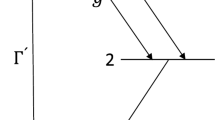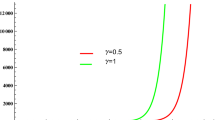Abstract
A model of single-atom laser with incoherent pumping is investigated theoretically. In the stationary case, a linear homogeneous differential equation for the phase-averaged Husimi Q function is derived from the equation for the density operator of the system. In the regime in which the coupling of the cavity mode with an atom is much stronger than the coupling of the mode with the reservoir ensuring its damping, the asymptotic solution is obtained to this equation. This solution makes it possible to describe some statistical features of the single-atom laser (in particular, the weak sub-Poissonian photon statistics).


Similar content being viewed by others
REFERENCES
I. R. Berchera and I. P. Degiovanni, Metrologia 56, 024001 (2019).
V. D’ambrosio, N. Spagnolo, L. Del Re, et al., Nat. Commun. 4, 2432 (2013).
S. Pogorzalek, K. G. Fedorov, M. Xu, et al., Nat. Commun. 10, 2604 (2019).
K. S. Tikhonov, A. D. Manukhova, S. B. Korolev, T. Yu. Golubeva, and Yu. M. Golubev, Opt. Spectrosc. 127, 878 (2019).
J. Shi, G. Patera, D. B. Horoshko, and M. I. Kolobov, J. Opt. Soc. Am. B 37, 3741 (2020).
S. Ritter, C. Nolleke, C. Hahn, et al., Nature (London, U.K.) 484, 195 (2012).
S. O. Tarasov, S. N. Andrianov, N. M. Arslanov, and S. A. Moiseev, Bull. Russ. Acad. Sci.: Phys. 82, 1042 (2018).
E. N. Popov and V. A. Reshetov, JETP Lett. 111, 727 (2020).
A. A. Sokolova, G. P. Fedorov, E. V. Il’ichev, and O. V. Astafiev, Phys. Rev. A 103, 013718 (2021).
D. F. Smirnov and A. S. Troshin, Sov. Phys. Usp. 30, 851 (1987).
S. Ya. Kilin and T. B. Krinitskaya, J. Opt. Soc. Am. B 8, 2289 (1991).
Yi Mu and C. M. Savage, Phys. Rev. A 46, 5944 (1992).
A. V. Kozlovskii and A. N. Oraevskii, J. Exp. Theor. Phys. 88, 666 (1999).
B. Jones, S. Ghose, J. P. Clemens, P. R. Rice, and L. M. Pedrotti, Phys. Rev. A 60, 3267 (1999).
T. B. Karlovich and S. Ya. Kilin, Opt. Spectrosc. 91, 343 (2001).
S. Ya. Kilin and T. B. Karlovich, J. Exp. Theor. Phys. 95, 805 (2002).
T. B. Karlovich and S. Ya. Kilin, Opt. Spectrosc. 103, 280 (2007).
T. B. Karlovich, Opt. Spectrosc. 111, 722 (2011).
N. V. Larionov and M. I. Kolobov, Phys. Rev. A 84, 055801 (2011).
S. Ya. Kilin and A. B. Mikhalychev, Phys. Rev. A 85, 063817 (2012).
N. V. Larionov and M. I. Kolobov, Phys. Rev. A 88, 013843 (2013).
E. N. Popov and N. V. Larionov, Proc. SPIE 9917, 99172X (2016). https://doi.org/10.1117/12.2229228
V. A. Bobrikova, R. A. Khachatryan, K. A. Barantsev, and E. N. Popov, Opt. Spectrosc. 127, 1070 (2019).
N. V. Larionov, in Proceedings of the 2020 IEEE International Conference on Electrical Engineering and Photonics EExPolytech (2020), p. 265. https://doi.org/10.1109/EExPolytech50912.2020.9243955
N. V. Larionov, J. Phys.: Conf. Ser. 2103, 012158 (2021). https://doi.org/10.1088/1742-6596/2103/1/012158
B. Parvin, Eur. Phys. J. Plus 136, 728 (2021).
D. B. Horoshko, Chang-Shui Yu, and S. Ya. Kilin, J. Opt. Soc. Am. B 38, 3088 (2021).
J. McKeever, A. Boca, A. D. Boozer, J. R. Buck, and H. J. Kimble, Nature (London, U.K.) 425, 268 (2003).
M. Nomura, N. Kumagai, S. Iwamoto, Y. Ota, and Y. Arakawa, Opt. Express 17, 15975 (2009).
F. Dubin, C. Russo, H. G. Barros, A. Stute, C. Becher, P. O. Schmidt, and R. Blatt, Nat. Phys. 6, 350 (2010).
A. H. Nayfeh, Introduction to Perturbation Techniques (Wiley-VCH, Weinheim, 1993).
L. Mandel and E. Wolf, Optical Coherence and Quantum Optics (Cambridge Univ., Cambridge, 1995).
G. S. Agarwal and S. Dutta Gupta, Phys. Rev. A 42, 1737 (1990).
F. M. Fedorov, Infinite Systems of Linear Algebraic Equations and Their Applications (Nauka, Novosibirsk, 2011) [in Russian].
Funding
This work was supported by the State assignment for fundamental research works (theme code FSEG-2020-0024).
Author information
Authors and Affiliations
Corresponding author
Ethics declarations
The author declares that he has no conflicts of interests.
Additional information
Translated by N. Wadhwa
APPENDIX
APPENDIX
Coefficients bik from Eq. (9) are given by
Rights and permissions
About this article
Cite this article
Larionov, N.V. Q Function for a Single-Atom Laser Operating in the “Classical” Regime. J. Exp. Theor. Phys. 134, 135–143 (2022). https://doi.org/10.1134/S1063776122020078
Received:
Revised:
Accepted:
Published:
Issue Date:
DOI: https://doi.org/10.1134/S1063776122020078




